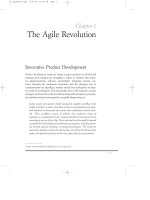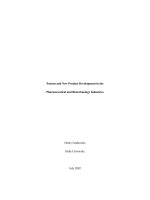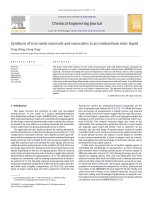Ionic liquid catalyzed selective product
Bạn đang xem bản rút gọn của tài liệu. Xem và tải ngay bản đầy đủ của tài liệu tại đây (222.13 KB, 5 trang )
Applied Catalysis B: Environmental 89 (2009) 137–141
Contents lists available at ScienceDirect
Applied Catalysis B: Environmental
journal homepage: www.elsevier.com/locate/apcatb
Ionic liquid-catalyzed selective production of hydrofluoroether: Synthesis
of a third generation CFC alternative, CF3CH2OCHFCF2CF3
Jin Hyung Kim a, Sunju Kwak a, Je Seung Lee a, Huyen Thanh Vo b, Chang Soo Kim b,
Ho-Jung Kang a, Hoon Sik Kim a,*, Hyunjoo Lee b,**
a
b
Department of Chemistry and Research Institute of Basic Sciences, Kyung Hee University, 1 Hoegi-dong, Dongdaemoon-gu, Seoul 130-701, Republic of Korea
Energy & Environment Research Division, Korea Institute of Science and Technology, 39-1 Hawolgok-dong, Sungbuk-gu, Seoul 136-791, Republic of Korea
A R T I C L E I N F O
A B S T R A C T
Article history:
Received 7 August 2008
Received in revised form 20 November 2008
Accepted 5 December 2008
Available online 11 December 2008
A hydrofluoroether, one of the third generation chlorofluorocarbon (CFC) alternatives, CF3CH2OCF2CHFCF3
was obtained in high yield and selectivity from the hydroalkoxylation reaction of hexafluoropropylene
and 2,2,2-trifluoroethanol conducted in the presence of an imidazolium-based ionic liquid catalyst such as
1-butyl-3-methylimidazolium acetate, 1-butyl-3-methylimidazolium bicarbonate, or 1-butyl-3-methylimidazolium carbonate. By using these ionic liquids, the formation of difficult-to-remove unsaturated side
products was effectively suppressed.
ß 2008 Elsevier B.V. All rights reserved.
Keywords:
Hydroalkoxylation
Hexafluoropropene
2,2,2-Trifluoroethanol
Ionic liquid
CFC alternatives
1. Introduction
Hydrofluoroethers (HFEs) have been considered as the most
promising candidates for refrigerants, cleaning solvents, and
blowing agents to replace chlorofluorocarbons (CFCs) and hydrochlorofluorocarbons (HCFCs), due to their zero ozone depleting
potential, low global warming potential, and favorable physical
and chemical properties including low surface tension, nonflammability, and excellent solvating ability [1–4]. HFEs have also
been regarded as an important class of fluorinated organic
compounds for many potential applications: heat transfer media,
particulate removal and carrier fluids, buffing abrasive agents,
displacement drying agents, power cycle working fluids, and
clinical usages [5–9].
Numerous methods have been reported to produce HFEs
including the fluorination of ether with F2 [10,11] or metal
fluoride [12], the electrochemical fluorination of ether [13], and the
alkylation of acyl halides using a sulfonic acid ester as an alkylating
agent in the presence of anhydrous KF [14,15]. However, these
methods suffer from either the low product selectivity or the
difficulty in handling the hazardous and reactive raw materials.
HFEs can also be obtained from the hydroalkoxylation reaction of
* Corresponding author. Tel.: +82 961 0432; fax: +82 2 961 0432.
** Corresponding author.
E-mail addresses: (H.S. Kim), (H. Lee).
0926-3373/$ – see front matter ß 2008 Elsevier B.V. All rights reserved.
doi:10.1016/j.apcatb.2008.12.001
commercially available fluorinated olefins (tetrafluoroethylene
and hexafluoropropylene) in the presence of a base catalyst or free
radical initiator [16–22], but these methods either require long
reaction time or produce relatively large amounts of unsaturated
HFEs were always co-produced, which are difficult to remove
by distillation due to the closeness in boiling points between
saturated and unsaturated HFEs.
Recently, Matsukawa et al. reported that the formation of
commonly observed unsaturated olefinic side products could be
completely suppressed by using a Pd0 complex, [Pd(PPh3)4] as the
catalyst for the hydroalkoxylation of fluoroolefins [23]. This is
a great finding, but the use of an expensive Pd complex seems to be
a major obstacle in the commercial application of this process.
Ionic liquids such as 1-ethyl-3-methylimidazolium tetrafluoroborate ([EMIm]BF4) and 1-ethyl-3-methylimidazolium hexafluorophosphate ([EMIm]PF6) were also employed as catalysts
and reaction media for the hydroalkoxylation of fluoroolefins, but
the yields of HFEs were not high even at elevated temperatures and
long reaction time [24], possibly due to the lack of basicity of
[EMIm]BF4 and [EMIm]PF6.
Since base catalysts such as NaOH and KF [16–21] are known to
be highly active for the hydroalkoxylation of fluoroolefins, it is
easily conceivable that a basic ionic liquid could proceed the
hydroalkoxylation more effectively than the neutral ionic liquids,
[EMIm]BF4 and [EMIm]PF6. It is also expected that the unique
properties of ionic liquids could suppress the formation of olefinic
side products. In this context, we have tested the performance of
138
J.H. Kim et al. / Applied Catalysis B: Environmental 89 (2009) 137–141
basic ionic liquids for the hydroalkoxylation of fluoroolefins to
produce HFEs.
Herein, we report that imidazolium-based ionic liquids with a
strongly basic anion such as CH3CO2À (AcOÀ), CO32À, and HCO3À
are highly effective for the hydroalkoxylation of hexafluoropropene (HFP, 1) with 2,2,2-trifluoroethanol (TFE, 2), producing a
saturated HFE (CF3CH2OCF2CHFCF3, 3) in high yield and selectivity.
2. Experimental
2.1. Materials
TFE, KF, K2CO3, potassium acetate (AcOK), imidazole, 1-methylimidazole, dimethylacetamide (DMAc), [BMIm]BF4, [BMIm]PF6,
and [BMIm]Cl were purchased from Aldrich Chemical Co. and used
as received. TFE was obtained from TCI Co. and used without
further purification. CF3CH2OCF2CHFCF3 and HFP were obtained
from Ulsan Chemical Co. and SynQuest Lab. Inc., respectively.
[BMIm]HCO3, [BMIm]CO3, [BMIm]AcO, methylimidazolium acetate [HMIm]AcO, imidazolium acetate [HIm][AcO], 1-butyl-2,3dimethylimidazolium acetate ([BDMIm]AcO), 1-ethyl-3-methylimidazolium acetate ([EMIm]AcO), and 1-hexyl-3-methylimidazolium acetate ([HexMIm]AcO) were prepared according to the
literature procedures [25–27].
2.2. Hydroalkoxylation of HFP
All the reactions were conducted in a 100-mL stainless-steel
bomb reactor equipped with a magnet bar, a thermocouple, a
sampling port, and a pressure gauge. The reactor was charged with
an appropriate catalyst, TFE, DMAc, and dibutylether as an internal
standard and was pressurized with 0.4 MPa of HFP. The bomb
reactor was then stirred at a room temperature. After the completion of the reaction, the reactor was cooled to À10 8C and the
product mixture was analyzed by a Hewlett Packard 6890 gas
chromatograph equipped with a flame ionized detector (FID), and
a HP-FFAP capillary column (30 m  0.32 mm  0.25 mm) or a
PoraPLOT Q capillary column (30 m  0.32 mm  0.25 mm). 1H
NMR spectra were recorded on a Varian UNITYplus-300.
0.2 mL of the pre-cooled product mixture contained in a 10-mL
Hamilton syringe was injected into the GC through a septum
placed on the top of the injector. The yield (100Â moles of
desired product/initial moles of TFE) of the major product
(CF3CH2OCF2CHFCF3, 3) and the conversion of TFE (100Â moles
of TFE converted/initial moles of TFE) were determined from a
calibration curve made using authentic samples (3 and TFE) and
the internal standard (dibutylether). The combined yield of low
boiling side products, 4–6 (cis/trans-CF3CF CFOCH2CF3 and
CF2 CFCF2OCH2CF3) was calculated based on the GC area ratio
(yield of 3Â area of a side product/area of 3) and the 1H NMR
integration ratio of side product/3 because authentic samples for
side products were not commercially available. For the analysis by
GC, it was assumed that compounds 3–6 have the same FID
response factor.
The combined yield of doubly alkoxylated side products, 7–8
(CF3CHFCF(OCH2CF3)2 and CF3CH2OCF2CHFOCH2CF3) was obtained
from a calibration curve made using dibutylether and a crude
mixture of 7–8 (purity: approximately 92%) recovered from a
distillation. Each GC sample was injected three times and the results
were averaged to reduce the experimental errors. The uncertainty of
the measurements was estimated as 2–3%.
PoraPLOT Q capillary column. Mass spectra of 3–8 representative
fragmentation peaks for each product component are provided
below (see also Fig. S-1 in the Supplementary Material).
CF3CFHCF3: m/z 151 (M–HF), 101(M–CF3), 69 (CF3); CF3
CHFCF2OCH2CF3, 3: m/z 231 (M–HF), 131 (M–CF3), 151 (CF3CHFCF2),
83(CF3CH2), 69(CF3); cis/trans-CF3CF CFOCH2CF3, 4, 5: m/z 230
(M+), 211 (M–F), 83 (M–CF3CH2O), 69 (CF3); CF2 CFCF2OCH2CF3, 6:
m/z 230 (M+), 180 (M–CF2), 149 (M–CF2 CF), 131(M–CF3CH2O), 83
(CF3CH2), 69 (CF3); CF3CHFCF(OCH2CF3)2, 7: m/z 311 (M–HF), 231
(M–CF3CH2O), 83 (CF3CH2); CF3CH2OCF2CHFOCH2CF3, 8: m/z 311
(M–HF), 181 (CHFCF2OCH2CF3), 149 (CF3CH2OCF2), 83 (CF3CH2O).
3. Results and discussion
3.1. Activities of imidazolium-based catalysts
The hydroalkoxylation reaction of HFP with TFE was investigated in DMAc for 1 h at an ambient temperature and at the molar
ratio of TFE/catalyst = 50 in the presence of an imidazolium-based
ionic liquid shown in Scheme 1.
For comparison, the activities of potassium salts were also
tested under the same experimental condition. As listed in Table 1,
KF, AcOK, and K2CO3 were highly active for the hydroalkoxylation,
resulting in almost quantitative conversion of TFE. However,
these potassium salt catalysts were not very selective for the
production of 3, due to the co-production of unsaturated HFEs
(cis-CF3CF CFOCH2CF3, 4, trans-CF3CF CFOCH2CF3, 5, and
CF2 CFCF2OCH2CF3, 6) in yield of about 10% as well as small
amounts of over hydroalkoxylated HFEs (see Scheme 2).
As already mentioned, the formation of such olefinic HFEs is a
headache in the purification of 3 by distillation because
compounds 4–6 have close boiling points to that of 3. It is
reported that, in the hydroalkoxylation of HFP with TFE using a
potassium salt catalyst, the formation of unsaturated HFEs are
inevitable because K+ is capable of eliminating b-fluoride from the
carbanion intermediate (CF3CÀFCF2OCH2CF3), formed by the
addition of CF3CH2OÀ to 1 [23]. It is also proposed that the
activity of alkali metal fluoride (MF) and the product composition
is greatly affected by the degree of dissociation of MF into M+ and
FÀ in a polar aprotic solvent and by the size of M+ [28]. These
observations strongly suggest that the formation of unsaturated
HFEs 4–6 can be controlled to a certain extent by designing a
catalyst with a suitable combination of cation and anion. In this
context, imidazolium-based ionic liquids were chosen as alternative catalysts because their physical and chemical properties can
be easily tailored by varying anions and/or cations [26]. It is hoped
that the acidic C-2 hydrogen of the imidazolium ring could
contribute to the stabilization of a plausible active species,
CF3CH2OÀ, through a hydrogen bonding. However, contrary to
our expectation, [BMIm]BF4 and [BMIm]PF6 exhibited almost no
2.3. Product characterization
Characterization of products was conducted using a Hewlett
Packard 6890-5973 MSD GC–Mass spectrometer equipped with a
Scheme 1. Structures of ionic liquids used for the hydroalkoxylation of HFP.
J.H. Kim et al. / Applied Catalysis B: Environmental 89 (2009) 137–141
Table 1
Activities of various potassium and imidazolium-based catalysts for the hydroalkoxylation of HFPa.
Entry
1
2
3
5
6
7
8
9
10
11
12b
13b
14b
Catalyst
KF
K2CO3
AcOK
[BMIm]BF4
[BMIm]PF6
[BMIm]Cl
[BMIm]AcO
[BMIm]HCO3
[BMIm]2CO3
Bu4NOAc
[BMIm]AcO
[BMIm]2CO3
[BMIm]HCO3
TFE conv. (%)
100
99.2
100
0.6
0.7
26.5
98.2
95.1
96.8
15.3
31.4
59.6
42.9
139
Table 2
Effect of the degree of alkyl substitution on the activity of imidazolium acetatea.
Entry
Catalyst
TFE conv. (%)
Yield (%)
3
4–6
7–8
89.6
89.4
90.5
0.5
0.6
23.4
96.5
93.3
94.6
14.1
29.5
56.3
40.6
10.3
9.6
9.2
0.1
0.1
2.8
0.8
0.8
1.0
1.0
1.8
2.1
2.2
0.1
0.2
0.3
–
0.3
0.9
1.0
1.2
0.2
0.10.20.1
a
Molar ratio of TFE/catalyst = 50 (TFE = 100 mmol), solvent = DMAc (10 mL),
temperature = 25 8C, reaction time = 1 h.
b
Molar ratio of TFE/catalyst = 150 (TFE = 100 mmol).
activity, and [BMIm]Cl showed only moderate activity under the
experimental condition (Table 1). It seems that the basicities of the
anions of these ionic liquids are not strong enough to generate
CF3CH2OÀ through the interaction with the weakly acidic hydroxyl
group of TFE.
In contrast to [BMIm]BF4, [BMIm]PF6, and [BMIm]Cl, imidazolium-based ionic liquids with a strongly basic anion, CH3CO2À
(AcOÀ), was highly active for the hydroalkoxylation. The yield of 3
reached to 96.5% at the molar ratio of TFE/[BMIm]AcO = 50 when
[BMIm]AcO was used as the catalyst. More importantly, the
formation of unsaturated side products, 4–6 was greatly reduced
down to 0.8%. This is a significant improvement when compared
with the hydroalkoxylation in the presence of a potassium salt.
[BMIm]HCO3 and [BMIm]2CO3 showed similar activity to
[BMIm]AcO, producing 3 in high yields and selectivities, whereas
[BMIm]Cl exhibited much lower activity. These results may imply
that the imidazolium salt with an anion of a weak acid is more
effective for the activation of TFE than those with an anion of a
strong acid in the hydroalkoxylation of HFP with TFE. Considering
the pKa values of HCl (À7.00), AcOH (4.75), H2CO3 (6.35), and
HCO3À (10.33), the lower activity of [BMIm]Cl can be ascribed to
the weaker basicity of ClÀ (conjugate base of HCl) compared with
those of AcOÀ, HCO3À and CO32À because more basic anion should
provide more stronger interaction with the hydroxyl group of TFE,
thereby facilitating the activation of TFE to generate an active
species, CF3CH2OÀ [29,30].
The effect of anion is more pronounced at higher molar ratio of
TFE/catalyst at 150 (see Table 2, entry 12–14). The imidazolium
salt with the most basic CO32À showed the highest activity,
1
2
3
4
5
6
[HIm]AcO
[HMIm]AcO
[BMIm]AcO
[BDMIm]AcO
[EMIm]AcO
[HexMIm]AcO
6.6
73.2
98.2
100
97.8
98.6
Yield (%)
3
4–6
7–8
0.1
62.9
96.5
98.8
96.3
97.0
6.5
9.0
0.8
0.4
0.9
0.7
–
1.3
0.9
0.8
0.6
0.9
a
Molar ratio of TFE/catalyst = 50 (TFE = 100 mmol), solvent = DMAc (10 mL),
temperature = 25 8C, reaction time = 1 h.
whereas the least basic AcO gave the lowest activity. However, at
the higher molar ratio of TFE/catalyst, the increased formation of
side products was also observed. It is noteworthy that the
activity of tetrabutylammonium acetate (Bu4NOAc) is much
lower than that of [BIMIm]AcO, demonstrating the important role
of imidazolium ring. It is likely that the basicity of AcOÀ and
the consequent interaction with TFE seems to be enhanced by the
presence of a bulky imidazolium ring.
3.2. Effect of alkyl substituents on the imidazolium ring
The effect of alkyl substitution on the imidazolium ring was also
investigated in the presence of an imidazolium acetate at the molar
ratio of TFE/catalyst = 50. The degree of alkyl substitution on the
imidazolium ring exerted a pronounced effect on the catalytic
activity. As listed in Table 2, the imidazolium acetate with two or
three alkyl groups on the imidazolium ring showed much higher
activity than those containing none or one alkyl group on the
imidazolium ring. The activity of the imidazolium acetate was found
in the order of increasing electron density on the imidazolium
ring: [BDMIm]AcO > [BMIm]AcO > [MIm]AcO) ) [HIm]AcO. The
increase of the electron donation from the alkyl group or groups
to the imidazolium ring will contribute to the increase of the
electron density on the imidazolium ring, consequently resulting
in the weakening of the electrostatic interaction between imidazolium cation and acetate anion. As a result, the hydrogen
abstraction from TFE becomes more feasible for the generation of
an active species, CF3CH2OÀ.
It is also noteworthy that the formation of unsaturated HFEs
decreased with the increasing electron density on the imidazolium
ring, i.e., with the decreasing acidity of the imidazolium cation. The
reduction in the acidity on the imidazolium cation is likely to limit
the interaction with the carbanion intermediate, and thus the
formation of unsaturated HFEs through the FÀ abstraction from
the carbanion intermediate seems to be suppressed. These
results strongly imply that the formation of unsaturated side
Scheme 2. Structures of the products from the hydroalkoxylation of HFP with TFE.
J.H. Kim et al. / Applied Catalysis B: Environmental 89 (2009) 137–141
140
Table 3
Effect of molar ratio of TFE/[BMIm]AcO on the hydroalkoxylation of HFPa.
Entry
1
2
3
4
5
Molar ratio
(TFE/[BMIm]AcO)
TFE conv. (%)
100
50
30
20
15
91.9
98.2
100
100
100
a
TFE = 100 mmol,
time = 1 h.
solvent = DMAc
(10 mL),
Yield (%)
3
4–6
7–8
88.6
96.5
98.4
99.0
99.4
2.2
0.8
0.4
0.3
0.2
1.1
0.9
0.8
0.7
0.4
temperature = 25 8C,
reaction
products, 4–6 could be further reduced if a methyl group or groups
are replaced by a functional group or groups with better electrondonating ability. The effect of alkyl chain length on the activity was
also evaluated, but any noticeable change in activity was not
observed with the variation of the alkyl chain.
Fig. 1. Effect of reaction time for the hydroalkoxylation of HFP (molar ratio of TFE/
[BMIm]AcO = 50, solvent = DMAc (10 mL), temperature = 25 8C): (&) conversion of
TFE, (*) yield of 3, (^) combined yield of 4–6, and (^) yield of 7–8.
3.3. Effect of catalyst concentration
Table 3 shows the change of TFE conversion and product
composition with the molar ratio of TFE/[BMIm]AcO for the
hydroxyalkoxylation reactions of HFP conducted in DMAc for 1 h.
The conversion of TFE and the yield of 3 increased gradually with
the decreasing molar ratio of TFE/[BMIm]AcO, while decreasing
the formation of side products, 4–6. The simultaneous increase of
the yield and selectivity of the major product is an important
advantage of the imidazolium acetate catalyst in terms of
industrial point of view. One may suspect that the olefinic side
products could be produced by the elimination of HF from 3.
However, such a pathway to the formation of olefinic side products
was excluded because any transformation of 3 was not observed
when 3 was reacted with TFE or HFP in the presence of [BMIm]AcO
in DMAc. From these results, it is concluded that the side product
is not the outcome of the secondary reaction of 3 and thus the
formation of side products can be further reduced by performing
the hydroalkoxylation reaction at higher concentration of a suitable catalyst.
3.4. Effect of reaction time
Effect of reaction time was also examined using [BMIm]AcO at
25 8C. The molar ratio of TFE/[BMIm]AcO was set at 50. A small
amount (0.3 mL) of sample was periodically taken out of the
reactor through the sampling port and analyzed by GC. As shown in
Fig. 1, the conversion of HFP increased continuously with the
reaction time and reached the maximum of 100% at 40 min. Any
change in conversion was not observed thereafter up to 120 min. In
contrast, yield of 3 decreased slightly after 40 min due to the
increase of the side products.
Scheme 3. A plausible mechanism for the formation of 3 and side products in the
presence of [BMIm]AcO.
formation of small amounts of CF3CHFCF3 is considered as the
result of the interaction of HFP with [BMIm]F formed in situ during
the catalytic cycle followed by the reaction with TFE as in Eqs. (1)
and (2) [20,23]:
CF3 CF¼CF2 þ ½BMImF ! ðCF3 Þ2 CFÀ ½BMImþ
(1)
3.5. Plausible reaction mechanism
Based on the experimental results, plausible pathways to the
formation of 3 and side products in the presence of [BMIm]AcO are
depicted in Scheme 3. TFE is likely to be activated first by AcOÀ of
[BMIm]AcO to generate CF3CH2OÀ, and AcOH. CF3CH2OÀ would
then interact with HFP to form a transient carbanionic intermediate A (CF3CÀFCF2OCH2CF3), which in turn transforms into 3
upon interaction with TFE or AcOH along with the generation of
CF3CH2OÀ or AcOÀ. Alternatively, FÀ can also be abstracted by
[BMIm]+ from the intermediate species A to give olefinic side
products 4–6 and [BMIm]F, but the process would be much slower
because the resulting [BMIm]F is highly unstable. Further
alkoxylation of 4–6 with TFE would produce 7 and 8. The
ðCF3 Þ2 CFÀ ½BMImþ þ CF3 CH2 OH
! CF3 CHFCF3 þ CF3 CH2 OÀ ½BMImþ
(2)
4. Conclusions
Imidazolium-based ionic liquids with a basic anion such as
CH3CO2À, HCO3À, and CO32À were highly effective for the
hydroalkoxylation reaction of HFP with TFE to produce 3 in high
yield while significantly reducing the formation of difficult-toremove olefinic side product. The formation of side products could
be further reduced either by increasing the electron density of
J.H. Kim et al. / Applied Catalysis B: Environmental 89 (2009) 137–141
imidazolium ring or by increasing the rate of reaction using larger
amounts of catalyst.
These novel imidazolium-based ionic liquid catalysts could be
applied to the synthesis of other hydrofluoroethers in high yield
and selectivity.
[8]
[9]
[10]
[11]
[12]
Acknowledgments
[14]
[15]
We acknowledge the financial support by a grant (AC3-101)
from Carbon Dioxide Reduction & Sequestration Research Center,
one of the 21st Century Frontier Programs funded by the Ministry
of Science and Technology of Korean government.
[16]
[17]
[18]
Appendix A. Supplementary data
[13]
[19]
[20]
[21]
[22]
[23]
Supplementary data associated with this article can be found, in
the online version, at doi:10.1016/j.apcatb.2008.12.001.
[24]
[25]
References
[26]
[1] A.R. Ravishankara, A.A. Turnipseed, N.R. Jensen, S. Barone, M. Mills, C.J. Howard, S.
Solomon, Science 263 (1994) 71–75.
[2] A. Sekiya, S. Misaki, J. Fluorine Chem. 101 (2000) 215–221.
[3] W.-T. Tsai, J. Hazard. Mater. 119 (2005) 69–78.
[4] J. Murata, S. Yamashita, M. Akiyama, J. Chem. Eng. Data 47 (2002) 911–915.
[5] D.D. DesMarteau, A.L. Beyerlein, I. Kul, US 06,546,740 (2003).
[6] D.D. DesMarteau, A.L. Beyerlein, I. Kul, US 06,574,973, (2003).
[7] F.G. Drakesmith, R.L. Powell, R.D. Chambers, B. Grievson, EP 0116417 (1984).
[27]
[28]
[29]
[30]
141
V.A. Petrov, US 5,994,599 (1999).
A. Berger, R.L. Simon, US 4,328,376 (1982).
H.N. Huang, D.F. Persico, R.J. Lagow, J. Org. Chem. 53 (1988) 78–85.
A. Sekiya, K. Ueda, Chem. Lett. (1990) 609–612.
M. Brandwood, P.L. Coe, C.S. Ely, J.C. Tatlow, J. Fluorine Chem. 5 (1975) 521–
535.
T. Abe, E. Hayashi, H. Baba, K. Kodaira, S. Nagase, J. Fluorine Chem. 15 (1980)
353–380.
R.M. Flynn, M.W. Grenfell, G.L. Moore, J.G. Owens, WO 22356 (1996).
S.H. Hwang, J.R. Kim, S.D. Lee, H. Lee, H.S. Kim, H. Kim, J. Ind. Eng. Chem. 13 (2007)
537–544.
J.A. Young, P. Tarrant, J. Am. Chem. Soc. 72 (1950) 1860–1861.
A.L. Henne, M.A. Smook, J. Am. Chem. Soc. 72 (1950) 4378–4380.
J.D. Park, W.M. Sweeney, S.L. Hopwood Jr., J.R. Lacher, J. Am. Chem. Soc. 78 (1956)
1685–1686.
R.E.A. Dear, E.E. Gilbert, J. Chem. Eng. Data 14 (1969) 493–497.
J. Murata, M. Tamura, A. Sekiya, Green Chem. 4 (2002) 60–63.
S. Okamoto, S. Yoshikawa, Y. Hibino, JP 2007-039376 (2007).
R.M. Flynn, M.G. Costello, USP 0,051,916 (2007).
Y. Matsukawa, J. Mizukado, H. Quan, M. Tamura, A. Sekiya, Angew. Chem. Int. Ed.
44 (2005) 1128–1130.
Y. Matsukawa, M. Tamura, A. Sekiya, JP 2006256967 (2006).
J.S. Wilkes, J.A. Levisky, R.A. Wilson, C.L. Hussey, Inorg. Chem. 21 (1982) 1263–
1264.
P.J. Dyson, M.C. Grossel, N. Srinivasan, T. Vine, T. Welon, D.J. Williams, A.J.P. White,
T. Zigras, J. Chem. Soc., Dalton Trans. (1997) 3465–3469.
M. Hasan, I.V. Kozhevnikov, M.R.H. Siddiqui, A. Steiner, N. Winterton, Inorg. Chem.
38 (1999) 5637–5641.
D. Natalia, D.Q. Nguyen, J.H. Oh, H. Kim, H. Lee, H.S. Kim, J. Fluorine Chem. 129
(2008) 474–477.
W.H. Brown, C.S. Foote, Organic Chemistry, Harcourt, Inc., New York, 2002, pp.
141–142.
R.J. Gordon, R.A. Ford, The Chemist’s Companion, John Wiley & Sons, Inc., New
York, 1972, pp. 58–63.









